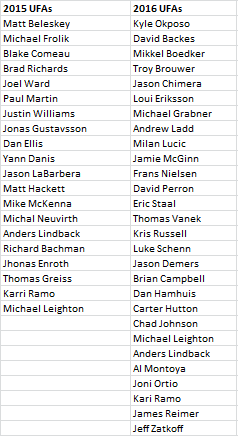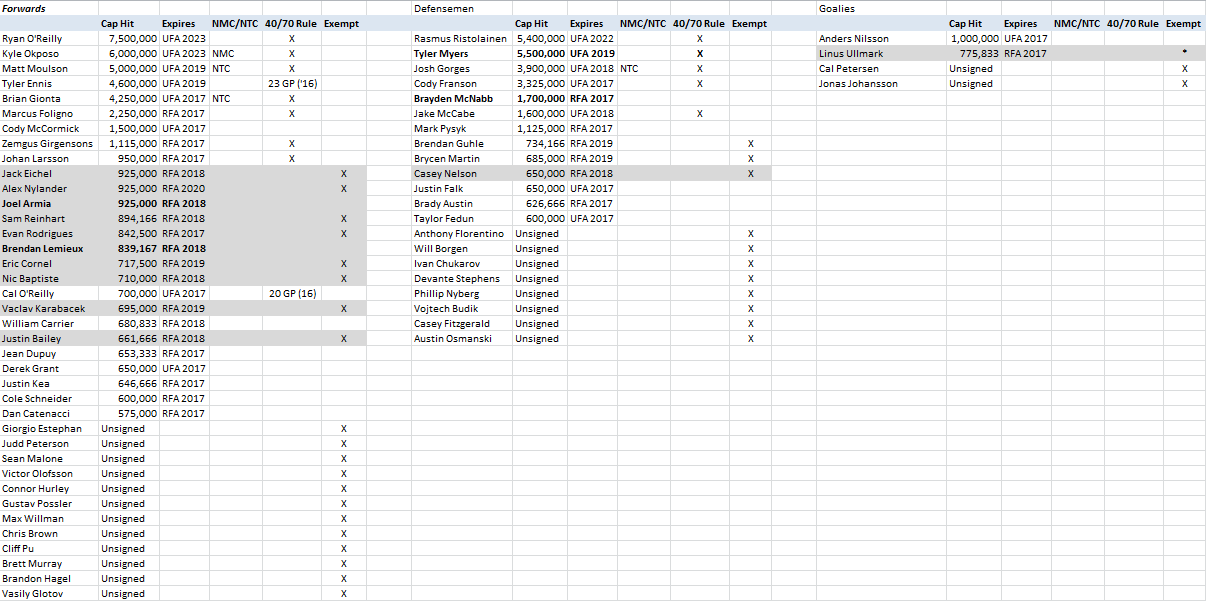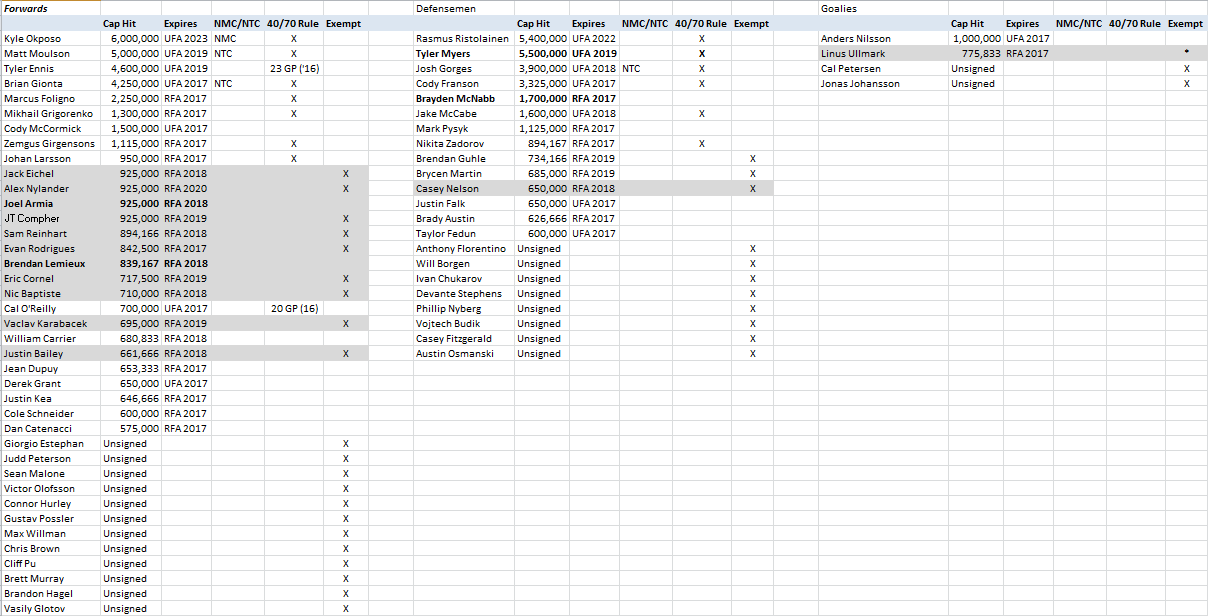An interesting story line has begun to emerge as the Sabres have struggled to move past the improvements made during the 2015-16 season.
With the team stuck in roughly the same spot they ended 2016 in, more fans are questioning the moves made by Tim Murray in an attempt to turn the Sabres from the basement dwelling fixer upper he inherited to the Cup contending team the fans and ownership are so desperate to see.
Due to a host of reasons, many self-inflicted, the lack of serious progress has raised questions ranging from the GM’s ability to evaluate talent to why the coach has made certain systemic decisions. Most of the questions that are being asked are well founded while others are simply ridiculous.

Given this prevailing feeling that nothing the Sabres have done is worthwhile, it seemed like a good time to evaluate the Sabres current situation. That meant giving an earnest evaluation of the good, the bad and even the ugly. This isn’t mean to be a dripping apologist post but an analysis that includes the nuance that so many in the fan base seem to ignore when criticizing the club.
Perhaps that lack of nuance is just a symptom of being a Buffalo sports fan these days. It’s almost like fans want the teams to fail so they can say ‘I told you so’. Pay no mind if Sam Reinhart is having yet another incredibly impressive season. Who cares if the Bills offense set a club record? All that seems to matter to far too many Buffalo fans is that they just knew Evander Kane, Doug Whaley or Tyler Ennis were overrated and they need to celebrate that fact. It’s a ridiculous form of masochism that’s best explored in another blog post at another time.
For now, exploring what’s gone wrong and why the Sabres are hardly lost at sea is the name of the game. Rather than start with what’s working and working towards what isn’t we’ll flip the script a bit. So rather than the good, the bad and the ugly, this will be the ugly, the bad and the good.
The Ugly
Aside from debating the usage and deployment from Dan Bylsma, easily the biggest sore spot for the Sabres this year has been the play and depth on the blueline. Faced with an already thin defensive corps, Tim Murray moved Mark Pysyk to Florida for Dmitry Kulikov on the second day of the draft. The logic was sound enough; Buffalo needed another left handed, top-four defender and Pysyk didn’t appear to have the same value with the organization that he does with many of the members of Sabres Twitter.
Kulikov doesn’t have the same advanced numbers that Pysyk does, which raises at least a few questions about what made him appealing to Murray over the summer, but on the face he was a needed addition to the group. It should be noted that there were rumors that Pysyk was being used as a trade chip by the previous regime as well. So it stands to reason that whatever in his game turned off Murray also turned off Darcy Regier and maybe even other hockey departments around the league.
On paper, Kulikov gave the Sabres a well-rounded top-four alongside Rasmus Ristolainen, Jake McCabe and Zach Bogosian. While the third pair left something to be desired, you at least had some confidence that the changes Murray had made gave the unit the injection of talent they needed. Then the preseason started.
Before the season opened, Kulikov suffered an odd back/butt injury after being checked into an open door during preseason play and Bogosian got banged up once again. Kulikov missed a couple of games at the beginning of the season and then two larger chunks later on. At this time he’s only played 20 games and he’s been out long enough that I’m left wondering how much the initial injury has affected his admittedly poor play this year.
Bogosian’s knock caused him to miss time earlier in the year and he remains quite visibly hobbled (and ineffective) at this point in the season. This has become something of old hat with Bogosian and at some point you simply need him to play a season at full health, but the injuries to he and Kulikov has certainly played a role for the Sabres.
Those two injuries are only part of the story, however. Josh Gorges continued to regress towards a bottom-pair defender and Cody Franson has offered little in the way of an upgrade for the three previously mentioned players.
Buffalo’s pipeline is unusually barren on the blueline as well. Brendan Guhle’s brief NHL debut (on emergency recall, mind you) certainly provides confidence for the future, but outside of Guhle, Will Borgen and Casey Fitzgerald, there’s little else to inspire confidence.
A great deal of this falls directly on the lap of Tim Murray. Rumors of a deal with Anaheim fizzled at the draft as it’s assumed the Ducks wanted eighth overall and Murray wasn’t willing to budge. If you’re looking for a decent barstool debate, try to decide if you’d rather have Alex Nylander growing in the minors or if you would rather have moved that pick in a package to get Fowler. For the sake of debate, assume the Sabres would have given up at least one NHL body (think Foligno or Ennis) and maybe even a quality prospect like Bailey or Baptiste.
Without Fowler in his pocket, Murray moved on Kulikov; a pending free agent who at least came along with Rasmus Asplund. That left him without Pysyk and a hobbled defenseman which nets out to a two-man loss depending how you view it.
Add in the incredibly questionable trade that sent Brayden McNabb and two second round picks to Los Angeles for Hudson Fasching and Nicolas Deslauriers and you’re left with a gaping hole where a pair of very good young defensemen would have otherwise presided. You can get really in-depth and even count Nikita Zadorov in this practice, but not only has he seriously regressed in Colorado, you’d be without Ryan O’Reilly and I can’t imagine many fans would walk that trade back.
Now, in my view, the negative impact the Pysyk trade has had wouldn’t even be discussed had Kulikov been healthy this year. He suffered a freak injury that has somehow lingered for the duration of the season. That’s just plain old bad luck, but it won’t change that this has been a bad trade for the Sabres. The depth along the blue line remains woefully insufficient and this is partially because of draft selections and partially due to draft position.
Removing Reinhart and Eichel from the equation (for obvious reasons), the Sabres have gone forward with five of their last six top-60 selections. In 2014 Brandon Montour (55) and Roland McKeown (50) are the two most notable defenders from the second round while Jeremy Roy (31), Travis Dermott (34), Brandon Carlo (37), Matthew Spencer (44), and Oliver Kylington (60) were all picked at or around where Buffalo’s selections sat in 2015. Realistically only Spencer and Kylington would’ve been available for the Sabres unless you really go down the rabbit hole with trades.
It’s hard to judge 2016 at this point but after just missing out on Olli Juolevi, the Sabres could’ve selected Mikhail Sergachev if they so chose. Like with the Fowler debate, I’ll leave it to you to decide what the best choice was – need or best player available?
What’s clear is that the defense is what’s dragging the Sabres down. There’s plenty of dead weight on the roster – much of which is yet again self-inflicted – but I’m not sure what’s commonly agreed upon as dead weight has done nearly as much damage as the blueline.
The Bad
That dead weight is one of the lingering side effect of the tank the Sabres embarked on. Players like Gorges and Matt Moulson were acquired to bridge the gap between the lowest point of the rebuild and the path forward. Unfortunately Moulson’s on-ice regression has been far more precipitous than anyone could have expected.
Add in Zemgus Girgensons, Cody Franson and Deslauriers and you’re left with a significant portion of the lineup that does very little besides eat cap space.
Of note here is that while everyone is quick to compare the Sabres and Maple Leafs rebuild in side-by-side fashion (which is dumb), the Leafs were able to be a little more creative with the cap space they ate up in order to dive to the bottom of the league standings. Rather than sign players who would actually suit up, Toronto brought in contracts like Nathan Horton’s to help sit above the floor while pushing young players through to the lineup.
Horton, Joffery Lupul, Milan Michalek, Brooks Laich and Colin Greening account for over $18 million of cap space yet none have contributed for the Leafs this season. Toronto also bought out Tim Gleason and Jared Cowen, creating vital space in the lineup while accounting for their cap requirements without the need for pesky veterans to weigh down the bottom six.
Obviously this was a stroke of genius for Toronto as it was simply an opportunity that didn’t really present itself to the Sabres, at least not in the extreme case as it did for the Leafs. Like with winning the lottery, it was a matter of right place, right time.
The good news for the Sabres is they get just over $9 million in relief this summer. Brian Gionta, Franson and Cody McCormick’s deals come off the books and you can add in another $4.3 million for Kulikov assuming he’s not retained. Buyouts to Gorges and Moulson would give some more relief as Gorges would account for a $1.3m hit for the next two years and Moulson would account for $2.833m, $3.833m and then $833K for two more seasons (it’s probably best to keep Moulson). So there’s certainly cap relief coming this summer – and that doesn’t even account for any stroke of luck they might encounter if Las Vegas takes a heavy cap hit off their hands.
What’s probably more impactful regarding the dead weight that dots the bottom six and defense corps isn’t their respective cap hits but the players they’re holding back. Will Carrier has carved out a spot in the lineup this year and is certainly going to be a valuable piece moving forward while Bailey and Baptiste are lighting up the score sheet in Rochester. None of those guys are shoe-ins for top-six roles, but they’re young, talented players capable of impacting the Buffalo lineup and game plan in a far different manner than Deslauriers, Moulson or Derek Grant.
That being said, the Sabres aren’t overflowing with elite, blue chip prospects at the moment, but the pipeline is hardly empty as well. There are strong assets on their way in Nylander, Guhle and Asplund, but the pipeline isn’t quite as full as it could have been.

Many of the shortcomings of Buffalo’s pipeline comes from Murray’s previous maneuvering. He’s traded away six top-60 selections through various trades since 2014. Some of those trades aren’t aging particularly well, magnifying the moves Murray has made. Look no further than spending the 21st overall selection on Robin Lehner and David Legwand.
Lehner, who has performed well for the Sabres since being acquired, just doesn’t appear to have it when it comes to being the type of starter you can lean on for a playoff run. It’s more than likely that the Lehner trade will go down as his worst – despite the fact that the McNabb deal should – and it will rest on the price he paid, not the performance of the player he received. Plenty has been said, written and Tweeted about the pitfalls of spending a first round pick for a goalie. While I subscribe to the theory that a goalie can indeed be worth a first round pick, I don’t think Lehner was that goaltender.
My personal choice in the summer of 2015 was Martin Jones. He was also acquired for the first round pick and has certainly justified that return. Not counting Lehner, Jones and Cam Talbot are the only two goalies from that trade market to really give their team any sort of serious return while Michal Neuvirth was the only true option via free agency. So options outside of Lehner weren’t exactly plentiful (nor were they this summer), but Murray certainly had other options.
While Murray probably didn’t make the right choice in acquiring Lehner, he certainly made it with the most information at his disposal. Kris Baker of Sabres Prospects made a great point recently as he noted that Lehner won a championship for him in Binghamton and had the track record as a prospect with the Senators that obviously gave Murray confidence. As one of the youngest goalies available via trade and the upside he provided, the recipe for a trade was there.
The move for Lehner is often referred to as one of the strongest examples of Murray’s aggressiveness hampering Buffalo’s pipeline. He’s moved a number of picks and looking back at his moves I’ve tired to determine what would be the organization’s greatest strength had he stood pat? Would they be stronger down the middle? Better off in goal? Deeper?

Trying to dig in on this alternate reality is a little tricky as you can’t determine who the Sabres would or wouldn’t have signed as free agents if certain trades hadn’t been made. For example, if O’Reilly and Kane aren’t here, does Kyle Okposo sign? Is Murray forced to overpay for lesser players in 2015 because he stood pat, kept his picks and needed to hit the floor? So some creative license is needed as you can go around in circles on what moves would or wouldn’t have followed others.
But what I can say definitively is that while the Sabres would have a wealth of talent in junior or NCAA at this time. They would still be staring at a somewhat similar logjam of dead weight as even in the best possible circumstances, they’d be shy the dollars and bodies to hit the cap floor each of the last two seasons. Additional challenges with fitting under the league’s 50 contract limit would have arisen down the line as there would be almost 10 more bodies in the system if Murray hadn’t moved on his big deals.
The debate here, of course, is if holding onto those picks would have paid off in the long run. I would tend to say yes in the sense that adding the likes of Colin White, Travis Konecny, Brock Boeser, Noah Juulsen or Sebastian Aho to the deck would really give the Sabres a boost as each came of age. Finding veterans to intermingle with those youngsters is a challenge for the entire league, let alone the Sabres, and again calls to mind some of the unknowns with trying to walk back trades and free agent signings.

Ed Note: Those players listed went at or around Buffalo’s picks in the 2015 draft, they wouldn’t have all of those players in the system.
It all comes down to value in the end. Have the Sabres gotten the value of the 21st and 25th picks from Robin Lehner and Evander Kane? Did getting aggressive in 2015 set up a better foundation than a more measured process would have? That’s where I tend to side with Murray in some respect.
The Sabres would certainly have the potential of injecting an untold amount of talent into their lineup around 2018 had they kept their picks. Many of the players fans wish the Sabres had selected may wind up as also-rans. That’s certainly been the case for a few of the players Buffalo moved who are already playing professionally. That point leads me to believe that the Sabres, in the short term, would be even worse off than they currently are.

If you’re losing sleep over the Leafs right now, just imagine how you’d feel knowing that most of your team’s help was at least two more years away. For such a frustrated fan base I can’t imagine waiting two more years for talent to arrive and maybe another year or two after that for it to blossom would go over very well.
What the end result is would be seeing Murray get active in the trade market this year, perhaps next summer as those assets came to age. Otherwise, more or less what you saw from him in 2015, just in a different market. Given the current league climate it would seem that Murray could poach a quality defenseman but finding NHL forward talent may not be quite as easy.
This is all academic, of course, as trying to handicap any sort of future trade market is impossible, just as is identifying who the Sabres would have in their stable had Murray taken a different route in years past. What seems to be under appreciated is the core that’s been built. Adding Ryan O’Reilly, Evander Kane and Kyle Okposo to Jack Eichel, Sam Reinhart, Rasmus Ristolainen and Jake McCabe built a strong foundation. Knowing some of Murray’s missteps will be behind him as early as this summer is nothing but a positive sign moving forward.
Part two of this post analyzing the good parts of Buffalo’s rebuild will come tomorrow
Add The Sports Daily to your Google News Feed!
